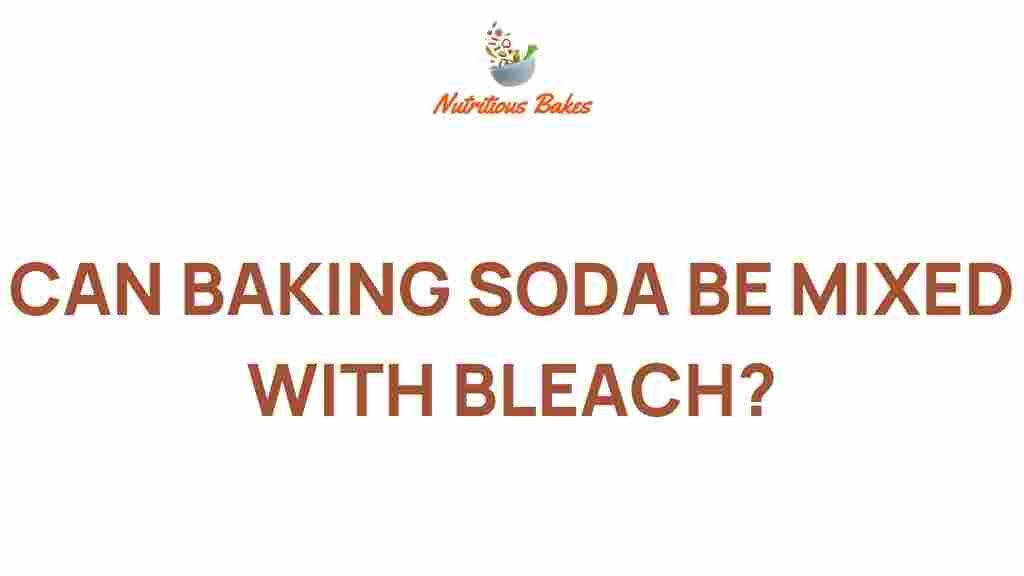The Surprising Risks of Mixing Baking Soda with Bleach
When it comes to household cleaning, many people turn to common products like baking soda and bleach for their effectiveness. Both are staples in many homes for their cleaning properties, but mixing them can lead to dangerous chemical reactions that pose significant health risks. In this article, we will explore the hazards associated with this combination, provide safety tips, and suggest safer alternatives for effective cleaning.
Understanding Baking Soda and Bleach
Baking soda (sodium bicarbonate) is a versatile household product known for its ability to neutralize odors, act as a mild abrasive, and assist in cleaning. It is often used in baking, but its cleaning properties make it a favorite for tackling stains and grime.
Bleach (sodium hypochlorite) is a powerful disinfectant and stain remover. It is commonly used in laundry, surface cleaning, and sanitizing. While bleach can effectively kill germs and bacteria, it is also a potent chemical that requires careful handling.
The Dangers of Mixing Baking Soda and Bleach
While both baking soda and bleach are effective cleaning agents on their own, mixing them can create hazardous reactions. Here are the primary risks:
- Chlorine Gas Production: When baking soda is mixed with bleach, it can produce chlorine gas, which is highly toxic and can cause respiratory issues, skin irritation, and eye damage.
- Inhalation Risks: Even small amounts of chlorine gas can lead to serious health problems. Symptoms of exposure include coughing, shortness of breath, and chest pain.
- Skin and Eye Irritation: Direct contact with the mixture can cause burns and irritation, making it dangerous for household cleaning.
Safety Precautions When Using Baking Soda and Bleach
To ensure safety while cleaning, it is essential to follow some precautions when using bleach and baking soda:
- Always use cleaning products in well-ventilated areas to minimize inhalation risks.
- Never mix bleach with any other cleaning products unless specified by the manufacturer.
- Wear protective gear such as gloves and goggles to protect your skin and eyes.
- Store cleaning products out of reach of children and pets.
Safe Cleaning Alternatives
If you need to clean effectively without risking dangerous chemical reactions, consider these safe alternatives:
- Vinegar: A natural disinfectant that can be used for cleaning surfaces, deodorizing, and removing stains.
- Hydrogen Peroxide: An effective disinfectant that can be used safely on surfaces without producing harmful fumes.
- Soap and Water: A simple mixture that can clean most surfaces effectively without chemical hazards.
Step-by-Step Cleaning Tips Using Baking Soda and Bleach Safely
If you want to use baking soda and bleach in your cleaning routine without mixing them, follow these steps:
- Identify the Task: Determine what you need to clean. Use baking soda for scrubbing surfaces and bleach for disinfecting.
- Clean with Baking Soda: Make a paste of baking soda and water for scrubbing surfaces like sinks and countertops.
- Disinfect with Bleach: Prepare a bleach solution according to the manufacturer’s instructions for disinfecting surfaces.
- Rinse Thoroughly: After cleaning with baking soda, rinse the surface before applying the bleach solution.
- Allow Time to Air Dry: Let the surface dry completely before using it again.
Troubleshooting Common Cleaning Issues
Here are some common cleaning issues and how to address them safely:
- Stubborn Stains: For tough stains, apply baking soda paste and let it sit for 15-30 minutes before scrubbing.
- Odors: Place an open box of baking soda in the refrigerator or other areas to absorb odors.
- Disinfecting Surfaces: If bleach is not suitable for certain surfaces, consider using vinegar or hydrogen peroxide as an alternative.
Health Risks of Mixing Baking Soda with Bleach
The health risks associated with mixing baking soda and bleach cannot be understated. Chlorine gas is not only harmful when inhaled but can also have long-lasting effects on lung function. Here are some specific health risks:
- Respiratory Issues: Exposure to chlorine gas can lead to chronic respiratory problems and asthma exacerbation.
- Skin Burns: Contact with the mixture can cause chemical burns, resulting in painful skin reactions.
- Eye Damage: Chlorine gas can severely irritate the eyes, leading to redness, pain, and potential vision loss.
When to Seek Medical Attention
If you accidentally mix baking soda and bleach and experience any of the following symptoms, seek medical attention immediately:
- Difficulty breathing or wheezing
- Severe coughing or chest pain
- Skin burns or irritation
- Eye irritation or vision changes
Conclusion
While baking soda and bleach are effective cleaning agents, mixing them can lead to serious health risks due to the production of toxic chlorine gas. By understanding the hazards and following safe cleaning practices, you can protect yourself and your family while maintaining a clean home. Always consider safer alternatives for cleaning and disinfecting, and remember to prioritize safety in your household cleaning routine.
For more household tips, visit our cleaning tips page.
For further reading on the dangers of mixing household cleaners, check out this external resource.
This article is in the category Tips and created by NutritiousBakes Team
